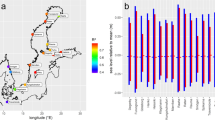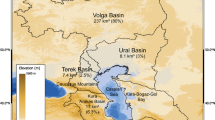Abstract
A statistical downscaling approach is applied to the output of five different global climate model simulations driven by twenty-first century future scenarios of greenhouse gas concentrations. The contribution of sea-level pressure (SLP) and precipitation changes to regional future winter sea-level changes is estimated for four Baltic sea-level stations by establishing statistical relationships between sea level as predictand and large-scale climate fields as predictors. Using SLP as predictor for the central and eastern Baltic Sea level stations, three climate models lead to statistically significant twenty-first century future trends in the range of the order of 1–2 mm/year. Using precipitation as predictor for the stations in the southern Baltic coast all five models lead to statistically significant trends with a range of the order of 0.4 mm/year. These numbers are smaller, but of the order of magnitude as the predicted global sea-level rise.



Similar content being viewed by others
References
Andersson H (2002) Influence of long-term regional and large-scale atmospheric circulation on the Baltic Sea level. Tellus 54A:76–88
BACC Author Team (2008) Assessment of climate change in the Baltic Sea Basin. Springer, Berlin, 474 p
Bogdanov VI, Medvedev MYu, Solodov VA, Trapeznikov YuA, Troshkov GA, Trubitsina AA (2000) Mean monthly series of sea level observations (1777–1993) at the Kronstadt gauge, vol 1. Reports of the Finnish Geodetic Institute, 34 p
Delworth T et al (2006) GFDL’s CM2 global coupled climate models, part 1: formulation and simulation characteristics. J Clim 19:643–674
Ekman M (1996) A consistent map of the postglacial uplift of Fennoscandia. Terra Nova 8:158–165
Ekman M (2003) The World’s Longest Sea level series and a winter oscillation index for Northern Europe 1774–2000. Small Publ Hist Geophys 12:30
Ekman M, Mäkinen J (1996) Mean sea-surface topography in the Baltic Sea and its transition area to the North Sea: a geodetic solution and comparison with ocean models. J Geophys Res 101:11993–11999
Gillett NP, Zwiers FW, Weaver AJ, Stott PA (2003) Detection of human influence on sea-level pressure. Nature 422:292–294
Giorgi P, Bi X (2005) Updated regional precipitation and temperature changes for the 21st century from ensembles of AOGCM simulations. Geophys Res Lett 32. doi:10.1029/2005GL024288
Gustafsson BG, Andersson HC (2001) Modelling the exchange of the Baltic Sea from the meridional atmospheric pressure difference across the North Sea. J Geophys Res 106:731–744
Hansen J et al (2002) Climate forcings in Goddard Institute for Space Studies SI2000 simulations. J Geophys Res 107(D18):4347
Hünicke B, Zorita E (2006) Influence of temperature and precipitation on decadal Baltic Sea level variations in the 20th century. Tellus 58A:141–153
Hünicke B, Zorita E (2008) Trends in the amplitude of Baltic Sea level annual cycle. Tellus 60A:154–164
Hünicke B, Luterbacher J, Pauling A, Zorita E (2008) Regional differences in winter sea-level variations in the Baltic Sea for the past 200 years. Tellus 60A:384–393
Hurrell JW (1995) Decadal trends in the north Atlantic oscillation: regional temperatures and precipitation. Science 269:676–679
Jevrejeva S, Moore JC, Woodworth PL, Grinsted A (2005) Influence of large-scale atmospheric circulation on European sea level: results based on the wavelet transform method. Tellus 57A:183–193
Jungclaus JH, Botzet M, Haak H, Keenlyside N, Luo JJ et al (2006) Ocean circulation and tropical variability in the coupled model ECHAM5/MPI-OM. J Clim 19:3952–3972
Kauker F, Meier MHB (2003) Modeling decadal variability of the Baltic Sea: 1. Reconstructing atmospheric surface data for the period 1902–1998. J Geophys Res 108:3267
Luterbacher J, Xoplaki E, Dietrich D, Rickly R, Jakobeit J et al (2002) Reconstruction of sea level pressure fields over the Eastern North Atlantic and Europe back to 1500. Clim Dyn 18:545–561
Meehl GA, Washington WM, Santer BD, Collins WD, Arblaster JM et al (2006) Climate change projections for the 21st century and climate change commitment in the CCSM3. J Clim 19:2597–2616
Meehl GA, Stocker TF, Collins WD, Friedlingstein P, Gaye AT et al (2007) Global climate projections. In: Solomon S, Qin D, Manning M, Chen Z, Marquis M, Averyt KB, Tignor M, Miller HL et al (eds) Climate change 2007: the physical science basis. Contribution of working group I to the fourth assessment report of the intergovernmental panel on climate change. Cambridge University Press, Cambridge
Meier HEM (2006) Baltic Sea climate in the late twenty-first century: a dynamical downscaling approach using two global models and two emission scenarios. Clim Dyn 27:39–68
Meier HEM, Broman B, Kjellström E (2004) Simulated sea level in past and future climates of the Baltic Sea. Clim Res 27:59–75
Miller RL, Schmidt GA, Shindell DT (2006) Forced annular variations in the 20th century intergovernmental panel on climate change fourth assessment report models. J Geophys Res 111:D18101
Mitchell TD, Jones PD (2005) An improved method of constructing a database of monthly climate observations and associated high-resolution grids. Int J Climatol 25:693–712
Osborn TJ (2004) Simulating the winter north Atlantic oscillation: the roles of internal variability and greenhouse gas forcing. Clim Dyn 22:605–623
Pauling A, Luterbacher J, Casty C, Wanner H (2006) 500 Years of gridded high-resolution precipitation reconstructions over Europe and the connection to large-scale circulation. Clim Dyn 26:387–405
Peltier WR (1998) Postglacial variations in the level of the sea: implications for climate dynamics and solid-earth geophysics. Rev Geophys 36:603–689
Ponte RM (1994) Understanding the relation between wind- and pressure-driven sea level variability. J Geophys Res 99:8033–8039
Pope VD, Gallani ML, Rowntree PR, Stratton RA (2000) The impact of new physical parametrizations in the Hadley Centre climate model: HadAM3. Clim Dyn 16:123–146
Räisänen J, Hansson U, Ullerstieg A, Döscher R et al (2004) European climate in the late twenty-first century: regional simulations with two driving global models and two forcing scenarios. Clim Dyn 22:13–31
Rosentau R, Meyer M, Harff J, Dietrich R, Richter A (2007) Relative sea level change in the Baltic Sea since the Littorina Transgression. Z Geol Wiss 35:3–16
Samuelsson M, Stigebrandt A (1996) Main characteristics of the long-term sea level variability in the Baltic Sea. Tellus 48A:673–683
Stephenson D, Pavan V, Collins M, Junge MM, Quadrelli R et al (2006) North Atlantic oscillation response to transient greenhouse gas forcing and the impact of European winter climate: a CMIP2 multimodel assessment. Clim Dyn 20:381–399
Trenberth K, Paolino DA (1980) The Northern Hemisphere sea-level pressure data set: trends, errors and discontinuities. Mon Weather Rev 108:855–872
Wilby RL, Wigley TML, Conway D, Jones PD, Hewitson BC, Main J, Wilks DS (1998) Statistical downscaling of general circulation model output: a comparison of methods. Water Resour Res 34:2995
Woodworth PL, Player R (2003) The permanent service for mean sea level: an update to the 21st century. J Coast Res 19:287–295
Acknowledgments
This study is part of the German Science Foundation project SINCOS and of the BALTEX program. I acknowledge the international modelling groups for providing their data for analysis, the Program for Climate Model Diagnosis and Intercomparison (PCMDI) for collecting and archiving the model data. I am grateful to E. Zorita for his help with this manuscript. I thank D. Bray for proof-reading.
Author information
Authors and Affiliations
Corresponding author
Rights and permissions
About this article
Cite this article
Hünicke, B. Contribution of regional climate drivers to future winter sea-level changes in the Baltic Sea estimated by statistical methods and simulations of climate models. Int J Earth Sci (Geol Rundsch) 99, 1721–1730 (2010). https://doi.org/10.1007/s00531-009-0470-0
Received:
Accepted:
Published:
Issue Date:
DOI: https://doi.org/10.1007/s00531-009-0470-0




